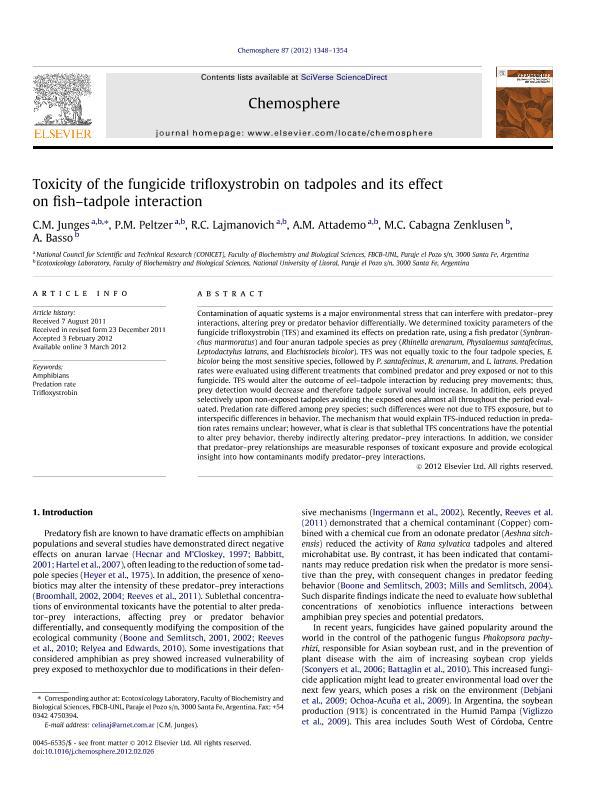Mostrar el registro sencillo del ítem
dc.contributor.author
Junges, Celina Maria

dc.contributor.author
Peltzer, Paola

dc.contributor.author
Lajmanovich, Rafael Carlos

dc.contributor.author
Attademo, Andres Maximiliano

dc.contributor.author
Cabagna Zenklusen, Mariana Cristina

dc.contributor.author
Basso, Agustin

dc.date.available
2021-07-13T15:57:54Z
dc.date.issued
2012-02
dc.identifier.citation
Junges, Celina Maria; Peltzer, Paola; Lajmanovich, Rafael Carlos; Attademo, Andres Maximiliano; Cabagna Zenklusen, Mariana Cristina; et al.; Toxicity of the fungicide trifloxystrobin on tadpoles and its effect on fish-tadpole interaction; Pergamon-Elsevier Science Ltd; Chemosphere; 87; 11; 2-2012; 1348-1354
dc.identifier.issn
0045-6535
dc.identifier.uri
http://hdl.handle.net/11336/135974
dc.description.abstract
Contamination of aquatic systems is a major environmental stress that can interfere with predator-prey interactions, altering prey or predator behavior differentially. We determined toxicity parameters of the fungicide trifloxystrobin (TFS) and examined its effects on predation rate, using a fish predator (Synbranchus marmoratus) and four anuran tadpole species as prey (Rhinella arenarum, Physalaemus santafecinus, Leptodactylus latrans, and Elachistocleis bicolor). TFS was not equally toxic to the four tadpole species, E. bicolor being the most sensitive species, followed by P. santafecinus, R. arenarum, and L. latrans. Predation rates were evaluated using different treatments that combined predator and prey exposed or not to this fungicide. TFS would alter the outcome of eel-tadpole interaction by reducing prey movements; thus, prey detection would decrease and therefore tadpole survival would increase. In addition, eels preyed selectively upon non-exposed tadpoles avoiding the exposed ones almost all throughout the period evaluated. Predation rate differed among prey species; such differences were not due to TFS exposure, but to interspecific differences in behavior. The mechanism that would explain TFS-induced reduction in predation rates remains unclear; however, what is clear is that sublethal TFS concentrations have the potential to alter prey behavior, thereby indirectly altering predator-prey interactions. In addition, we consider that predator-prey relationships are measurable responses of toxicant exposure and provide ecological insight into how contaminants modify predator-prey interactions.
dc.format
application/pdf
dc.language.iso
eng
dc.publisher
Pergamon-Elsevier Science Ltd

dc.rights
info:eu-repo/semantics/openAccess
dc.rights.uri
https://creativecommons.org/licenses/by-nc-sa/2.5/ar/
dc.subject
AMPHIBIANS
dc.subject
PREDATION RATE
dc.subject
TRIFLOXYSTROBIN
dc.subject.classification
Otras Ciencias Biológicas

dc.subject.classification
Ciencias Biológicas

dc.subject.classification
CIENCIAS NATURALES Y EXACTAS

dc.title
Toxicity of the fungicide trifloxystrobin on tadpoles and its effect on fish-tadpole interaction
dc.type
info:eu-repo/semantics/article
dc.type
info:ar-repo/semantics/artículo
dc.type
info:eu-repo/semantics/publishedVersion
dc.date.updated
2021-07-13T12:30:26Z
dc.journal.volume
87
dc.journal.number
11
dc.journal.pagination
1348-1354
dc.journal.pais
Estados Unidos

dc.description.fil
Fil: Junges, Celina Maria. Universidad Nacional del Litoral. Facultad de Bioquímica y Ciencias Biológicas; Argentina. Consejo Nacional de Investigaciones Científicas y Técnicas. Centro Científico Tecnológico Conicet - Santa Fe; Argentina
dc.description.fil
Fil: Peltzer, Paola. Universidad Nacional del Litoral. Facultad de Bioquímica y Ciencias Biológicas; Argentina. Consejo Nacional de Investigaciones Científicas y Técnicas. Centro Científico Tecnológico Conicet - Santa Fe; Argentina
dc.description.fil
Fil: Lajmanovich, Rafael Carlos. Universidad Nacional del Litoral. Facultad de Bioquímica y Ciencias Biológicas; Argentina. Consejo Nacional de Investigaciones Científicas y Técnicas. Centro Científico Tecnológico Conicet - Santa Fe; Argentina
dc.description.fil
Fil: Attademo, Andres Maximiliano. Universidad Nacional del Litoral. Facultad de Bioquímica y Ciencias Biológicas; Argentina. Consejo Nacional de Investigaciones Científicas y Técnicas. Centro Científico Tecnológico Conicet - Santa Fe; Argentina
dc.description.fil
Fil: Cabagna Zenklusen, Mariana Cristina. Universidad Nacional del Litoral. Facultad de Bioquímica y Ciencias Biológicas; Argentina
dc.description.fil
Fil: Basso, Agustin. Universidad Nacional del Litoral. Facultad de Bioquímica y Ciencias Biológicas; Argentina
dc.journal.title
Chemosphere

dc.relation.alternativeid
info:eu-repo/semantics/altIdentifier/doi/http://dx.doi.org/10.1016/j.chemosphere.2012.02.026
Archivos asociados
